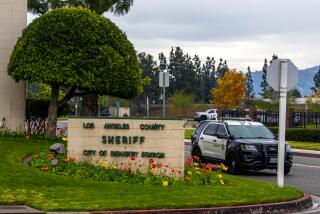Penn Prosecution Upbeat on New Tactics : Changes in Witnesses, Evidence Mark Retrial in Police Shootings
- Share via
After seven weeks, the prosecution rested its case Thursday in the retrial of suspected police killer Sagon Penn--a case more streamlined and pointed than the one it presented in Penn’s first trial a year ago.
Deputy Dist. Attys. Michael Carpenter and Wayne Mayer called 48 witnesses to testify about the shooting death of San Diego Police Agent Thomas Riggs and the wounding of Agent Donovan Jacobs and civilian ride-along Sarah Pina-Ruiz in Encanto in March, 1985.
By comparison, Carpenter paraded more than 80 witnesses to the stand in Penn’s first trial, which ended in June with the 25-year-old black man’s acquittal on murder and attempted murder charges and a deadlocked jury strongly favoring acquittal on the lesser charges on which Penn is being retried.
Though the prosecution case took two weeks longer to present this time, the district attorney’s office appeared to score fewer inadvertent points for the defense than it did in the first trial, and to set out a more easily comprehended version of the events than emerged a year ago.
“I was pleased with the way the evidence came in,” Carpenter said Thursday. “The chronology and the people we involved were effective.”
Defense attorney Milton Silverman--who opened his case late Thursday afternoon--was also upbeat over the progress of the proceedings. But the defense lawyer acknowledged that he will have to do more of his own work in the retrial.
Last year, he said, Carpenter called so many eyewitnesses who were critical of Jacobs’ conduct during the confrontation in Encanto that they nearly made the defense case before he called his first witness.
“So the full impact of defense testimony will come later than it did the first time,” Silverman said.
Jacobs was the lead-off prosecution witness in the retrial, testifying for nearly a week--much of it under unrelenting cross-examination by Silverman, whose defense of Penn is built on the contention that Jacobs is a hot-headed racist whose misconduct incited the deadly events on March 31, 1985. Pina-Ruiz was the second major witness called by Carpenter.
In contrast, Jacobs and Pina-Ruiz were the last witnesses Carpenter called during the first trial, and their testimony was immediately--and repeatedly--contradicted by a string of defense witnesses.
Carpenter said the tactical switch allowed for a more cogent presentation of the prosecution’s version of the events.
“Jacobs being first tells the jury what he’s doing there to begin with, rather than having them wonder like they did the last time,” the prosecutor said. “Pina-Ruiz being second was because she is an eyewitness and victim, and had the best view of everything.”
Silverman said the switch in the order of prosecution witnesses will make little difference in jurors’ analysis of the evidence.
“I think the difference is that Jacobs will be discredited eventually instead of being discredited immediately,” he said.
New Evidence for Jurors
Jurors in the retrial also have been exposed to evidence that did not surface in Penn’s first trial:
- The retrial jury heard a tape recording of the initial police interview with Penn after he turned himself in the night of the shootings.
Carpenter successfully blocked admission of the tape as evidence in the first trial--because, he says now, he wanted to encourage Penn to take the stand himself.
Penn did not testify in the first trial, however, and on the assumption that he again will not, Carpenter said the tape “was better than nothing to get his version, even though there’s a lot that’s self-serving in it.”
In the tape, Penn said Jacobs started the altercation and that the officer said “a whole bunch of negative things to me.” Penn also said that he “was tryin’ to protect my life” when he shot the officers and Pina-Ruiz.
- The jurors saw a graphic videotape of the shooting scene, including pictures of Riggs’ bullet-torn body. The tape was lost by the San Diego Police Department for several months and not found until after the first trial. Silverman unsuccessfully sought a mistrial in the retrial after it was presented to the jury.
For all the new evidence, however, the jurors have not yet heard testimony that their counterparts in the first trial had been exposed to by the time Silverman began the defense case:
- Several eyewitnesses to the shootings whom Carpenter called to the stand in the first trial have not testified. Carpenter acknowledged that, in many instances, their testimony aided Silverman’s case more than his. But Carpenter also held back prosecution witnesses whose testimony Silverman challenged sharply in cross-examination during the first trial, including a nurse who examined Penn and one eyewitness whose story changed repeatedly.
- Prosecutors have all but abandoned their original contention that Penn turned to Pina-Ruiz and said, “You’re a witness” before shooting her twice.
Carpenter and Mayer did not call Dwayne Williams, who testified during the first trial that he had heard Penn warn Pina-Ruiz. An FBI expert called by the prosecution testified that only nine-tenths of a second elapsed between the last shot fired at Riggs and the first shot fired at Pina-Ruiz--hardly enough time for Penn to have shouted at the woman.
Still, it was a smiling Carpenter who whispered into Mayer’s ear as Silverman concluded his cross-examination and joked with jurors in the atmosphere of relative joviality that has made Superior Court Judge J. Morgan Lester’s courtroom a far different environment from the stern setting established by Judge Ben W. Hamrick in the first trial.
“I felt really good last time at this stage,” Carpenter said. “I felt really good when it went to the jury last time. I feel real good this time. Maybe I’m a cock-eyed optimist.”
More to Read
Sign up for Essential California
The most important California stories and recommendations in your inbox every morning.
You may occasionally receive promotional content from the Los Angeles Times.










